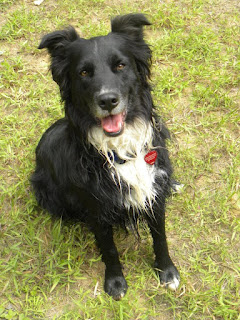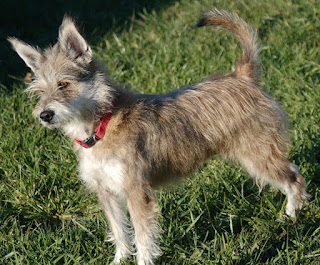Each Sunday morning I wake up anticipating a nice long walk with the dogs. These walks are the highlight of our week – we have time to ramble along instead of rushing to get back in time for work. As I planned this morning’s walk in my head, I remembered the stray hound dog I am holding while trying to find her owners. “Sweet Pea” is a quiet, friendly dog that really likes attention. I hated to leave her home alone so I thought “what’s one more?” and grabbed another leash.
Walking one or two dogs on leash can be challenge enough, but I frequently walk three or four dogs on leash together. This morning I didn’t think twice about adding a fourth dog to our morning line up even though Sweet Pea obviously has spent little or no time on leash. Our walk had a couple of less-than-graceful moments (which were only to be expected) but otherwise was relaxing, enjoyable and went very well.
Let me share some of my tips for walking multiple dogs:
- Have a lineup. Know which dog you want where. In my pack, Pip generally walks furthest to the left, Nellie in the middle and Ben furthest to the right. This isn’t set in stone but the dogs know the routine and generally default to this line up. When I add a new dog, they go to the right of Ben so I can manage my three dogs with my left hand and have my right (dominant) hand free to wrangle the new dog.
- If you have a dog that is nervous about traffic, put him on the side of the lineup that will keep him furthest away from oncoming vehicles. This way, if he spooks away from the vehicles he won’t be tangling the leashes and running through other dogs.
- Don’t let a dog crossover, especially not behind you. If a dog tries to cross from one side to the other in front or behind you, use his leash to return him to his appropriate position as soon as possible. Make sure you lead him back on the same path that he took – don’t allow him to circle around behind you. Circling not only takes two hands to untangle the leash, he will wrap his leash around your legs and risk tripping you as well as snarling the leashes. If you are firm and consistent, your dogs will quickly learn to walk without weaving and tangling.
- Good leash handling is critical to enjoying a multiple dog walk. Tangles are inevitable but how you hold your leashes will prevent tangles and allow you to respond quickly to changes in the line up. Never wrap or bundle the leashes and don’t loop leashes over your wrist. You will not be able to respond quickly enough to prevent tangles or correct your dog’s position if you can’t get one leash free in an instant. Let the tail ends of the leashes hang free so they don’t knot together when you adjust leashes.
- Hold your horses. I like to hold my leashes like I would a rein while riding horses. The leash runs from my dog, over my pinkie finger, under my ring, middle and index fingers and out over my thumb (my palm would be facing down with the thumb closest to my body). This way, I have a powerful grip on the leash (I can hold all three of my dogs in my left hand this way – even if they try to bolt after something) but I can also access each individual leash rapidly. Often, I’ll run each leash through a different finger (one between pinkie and ring finger, one between ring finger and middle finger, etc) so it is even easier to grab the leash I want with my free hand.
- Having lots of pretty leashes helps. I love the look and feel of leather leashes, but I use different colored nylon leashes for walking. This allows me to instantly recognize which leash I need to grab to redirect an individual dog. Narrower or less bulky leashes are helpful so you can comfortably hold them all in one hand. (I prefer ¾ inch leashes to 1 inch wide leashes for this reason.)
- Keep moving – tangles frequently happen when the pack stops or tries to turn tightly. Instead of turning tightly, stop and walk rapidly backwards until all the dogs turn and walk towards you. You can then redirect them or turn yourself and walk back the other way.
- Teach an autosit. This allows you to stop without the dogs milling around and tangling the leashes around your legs. It’s easiest to teach autosits to dogs individually and then practice as a group. The easiest way to practice is with treats. Walk along for several strides, stop and ask your dog to sit immediately. Keep this up until the dog starts to anticipate your command. Reward for sitting immediately when you stop. You want your dog’s default behavior be to sit when you stop walking whether you ask or not. Solid sits are also very helpful when you are trying to leash or unleash multiple dogs.
- Keep calm and carry on. Use your “leave it” command or “walk on” to keep the pack focused on you and moving forward past exciting obstacles like bear poop, taunting squirrels and small, yappy yard dogs. If the dogs slow down, maintain your pace so they have to keep up with you (you will feel like you are pulling them along to start with). If you stop every time one of three or four dogs wants to sniff something, you will never make it out of the yard.
- Pick your position – in front or even with you. I prefer my dogs to walk out in front of me. It makes crossing over and circling behind easier to control and it keeps the slack out of their leashes so they are less likely to get the leash tangled around their legs.
- Train dogs to different sides to make management easier. As I said before, Pip and Nell walk to the left and Ben to the right. They also heel to those respective sides. Put your more challenging dog or biggest dog in your dominant hand. Group less challenging or smaller dogs in your less dominant hand. Yeah, I know the AKC says your dog should heel on the left but no one is judging you out there on the road. Do what works and is most secure for you.
- Some people like couplers but they don’t work for my dogs. If you use a coupler, make sure the dogs are similar in size, weight and temperament. It isn’t fair to couple a timid, nervous or small dog to another dog that will simple drag it through the walk. If you have a dog that is at all aggressive or prone to redirecting frustration as aggression, do not use a coupler.
- While front connect harnesses and, to a lesser extent, head halters can be useful tools in the right situations, they can cause challenges when walking a large group of dogs. The lower connection point of the leash makes it more likely that dogs will get their legs up and over the leash and cause a tangle. It is not fair or healthy for a dog with a head halter to be jerked or yanked because someone else got tangled up in his leash. I prefer to use just regular collars when walking larger numbers of dogs or adding a new dog to the mix.
- Remember that you are outnumbered and may be outweighed. In the event that the dogs lunge forward as a group (ie., the sudden appearance of a suicidal squirrel), keep your elbows in close to your body, your arms bent at the elbow and rock your weight back on your heels. This will allow you to use your arm and back muscles to absorb the pull and your body weight to slow them down. If you let your arm get pulled straight or your body weight pulled forward, you could wind up in a dangerous situation and be pulled forward or off your feet. Likewise, never wrap or loop your leashes over your arm. In the event of an emergency, it is better to be able to drop your leashes and let your dogs go than to get pulled off your feet, dragged or hurt. For these reasons, don’t ever walk more dogs than you can physically control if the worst should happen, no matter how well trained they might be.
So grab a couple of dogs, or three or four if you have them, and go for a walk!










